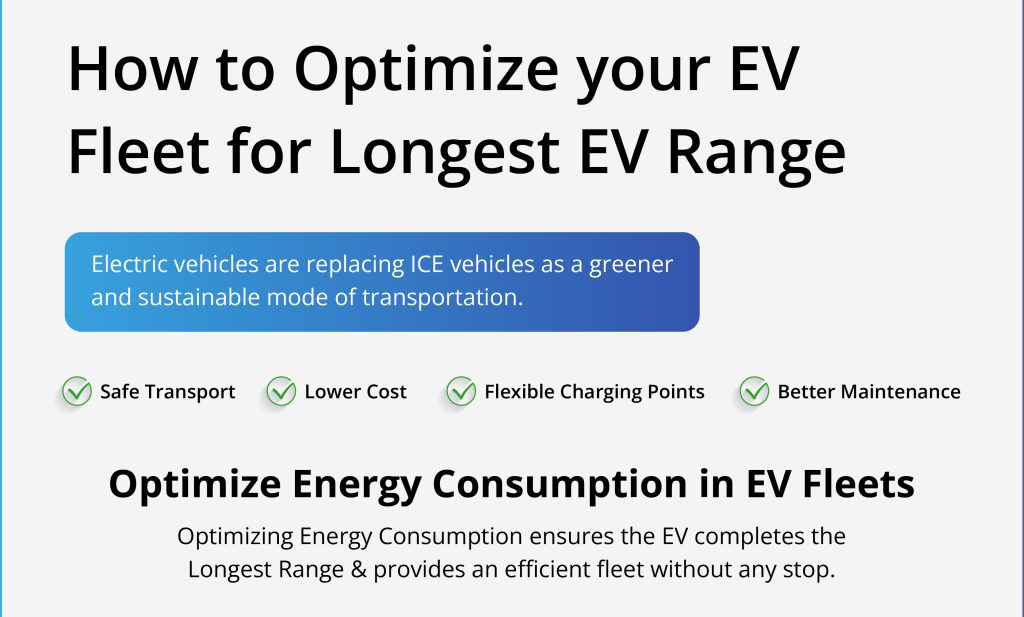Electric vehicles are gaining prominence as the preferred mode of transport, which is cleaner, greener, and sustainable. It provides a range of advantages, from safe transport, lower cost, flexible charging points, and better maintenance. It elaborates on optimizing the EV fleet to ensure it covers the maximum range.
This article discusses how connected vehicle data is advantageous in optimizing battery use and enhancing the driving experience for long-range EV cars.
Optimize Energy Consumption in EV Fleets
Optimizing energy consumption in EV cars helps in saving battery usage. In addition, it will ensure the EV completes the longest range and provide an efficient fleet without any stops.
1. Understanding Electric Car Range
The distance calculates the range of an electric car traveling on a single charge. It is based on the miles per gallon, i.e., gasoline-equivalent (MPGe). Therefore, it is only an estimated range that varies as per the mileage and other factors as listed below:
2. Factors Affecting The EV Range
1. Speed
EV car range ranks above compared to ICE vehicles. It includes accurately maintaining charge using regenerative brakes while moving in traffic. Although constant stop and move of EVs in traffic are essential, speed also affects maintaining EV with the longest range.
2. Charge Capacity
EVs are affected by their charging capacity, which is optimized with complex battery systems. It helps in limiting the overall charge utilized and prolongs the battery life. An electric vehicle is never charged to its fullest capacity. It is an essential factor to consider as many charging ports for EV increase the level up to 80% within 30 minutes.
3. Battery Age
Batteries tend to lose their capacity of maximum charge with age. However, the batteries come with a 100,000-mile warranty and a degradation rate of 2.3% per year, ensuring it performs for a prolonged period.
4. Weather
Weather is one factor that primarily affects the battery’s capacity negatively during low temperatures. Placing the battery in a cool or warm place affects its range as it tends to draw more battery.
Vehicle Preconditioning
Vehicle preconditioning is a lucrative way to optimize battery usage. It includes preconditioning the vehicle when charging. It includes switching the heat or A/C when the charging point is still plugged in. It enables bringing the vehicle to a suitable temperature. Additionally, it allows us to maintain the cabin condition rather than using the car’s battery power.
Optimizing Routes to reduce EV Range Anxiety and to Achieve Long EV Range
Range anxiety determines the owner’s fear of the battery not charging sufficiently to reach the destination. Connected vehicle data allows owners to plan EVs’ daily routes by utilizing greater daily mileage than a consumer vehicle. Herein, unplanned stops in between 30 minutes affect the fleet.
Connected vehicle data lets owners plan the vehicle’s route by considering various factors such as distance, number of stops, traffic conditions, road conditions, and weather. Optimizing routes helps choose the right charging partners and charge point networks.
CerebrumX’s streaming telemetry enables real-time status by collecting data related to speed, location, acceleration, and direction. This information helps optimize fleet navigation, find the shortest routes, maximize utilization, and find real-time ETAs.
Tracking The Battery Performance of EV Fleet
Accurate battery management is imperative to ensure it stays within safe limits. Connected vehicle data ease the process of tracking the battery performance for EV fleets and how it can be used to prolong the battery life.
CerebrumX assists in tracking the battery performance using its AI intelligence to transit to a sustainable future using EVs. It provides a range of advantages, which include:
1. Ease Range Anxiety with DTE Updates
Tracking the EV fleet and using DTE updates allows for understanding the required speed and distance to reduce overall longest-range EV fleet anxiety.
2. Charge Planning for Managing Range Anxiety
Get accurate battery consumption data by analyzing destination and speed using the update. It helps plan to charge, manage range anxiety, and enjoy an efficient fleet.
3. Finding the Nearest Charging Station
CVD uses multiple vehicle sensors and GPS to track the nearest charging station, ensuring optimal vehicle battery use. The real-time data further assists in finding the nearest charging stations to confirm that the vehicles are efficiently charged for a fleet.
4. Remotely Handle Public Charging Transactions
It helps to acquire network insights remotely and perform most of the operations.
Analyze Battery Drainage Trends
Constant cooling and heating of the battery pack and the cabin drain the battery power. Multiple reasons lead to the draining of the battery. Parameters such as lighting, audio, driver assistance, infotainment, etc., affect the charging levels.
A few factors for analysis include:
- Training driver
- Checking temperature and weather
- Traffic volume
- Available EV charging stations
- Analyzing battery drain
Some of the tips for analyzing EV range include:
- Use energy-efficient heated seats and steering wheels
- Switch on the eco-friendly mode to add the extra mile to your vehicle
- Employ different regenerative settings for brakes to get the longest range on your EV
- Make use of the car’s connected vehicle data app to limit EVs with the best range and charge up to 80%
Conclusion
CerebrumX-connected vehicle data insights assist fleet management in optimizing overall energy consumption. It allows owners to reduce the impact of electric vehicle range. It provides users with a range of factors, such as temperature, road conditions, battery usage, distance, etc., to accurately plan their EV fleet and plan EV range without the worry of range anxiety. Connect to us today to enhance your EV experience.






